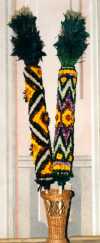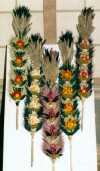
|
PALM SUNDAY PALMS [ a.k.a. VERBOS ]
The Christian world celebrates Jesus' noble entry into Jerusalem on
the last Sunday befor Easter. In Lithuania this day is called Verbø
Sekmadienis – Palm Sunday. When Christianity came to Lithuania, plants
which sprouted earliest were honored during spring feasts. Even now, willows,
osiers and weeping willows are consecrated on Palm Sunday. Mythological
folklore relates that one of the willows, called Blindë, had been
a very fertile woman, bearing numerous children. Earth, the most fertile
mother was jealous of her. When Blindë walked through a wetfield,
her feet sank into the mud. Blindë turned into a willow tree out of
great sadness.
The osier, with male spores was regarded as an unusual tree. Folklore
tells that the osier grew out of a secretly murdered man. A fife made of
osier wood, speaks in a man's voice. Evil spirits avoid it because of its
red color.
Most palm bunches have a branch of juniper in them. Juniper is green
year round, with late ripening berries and with a peculiar odor. All these
plants are principal components of palms, however cranberry, mistletoe,
filbert and oak branches together with dried baby's breath and ferns are
among the odd numbered pieces in the palm. Pussy willows, hepaticas and
some indoor plants are added to give color to the palms. When Christianity
was established in Lithuania, palms were consecrated in church. The ancient
tradition of whipping each other with palms, still exists, takes place
on Palm Sunday or on Easter Sunday. Having returned home with consecrated
palms, one whips the head, back shoulders of those who stayed home, repeating
all the time, " illness out, health return". The following words were spoken
or sung, when striking with the palm:
I am not the one striking
The Palm is striking
You are not in pain
The Palm is in pain
Soon it will be Easter
OR
It is not I who is thrashing, but the rod
It will thrash until it breaks
The great day is in a week
It will entertain everyone
Remain the same as you have been
Be healthy as a fish.
The first lines of these charm words are the same throughout Lithuania,
the rest changes. Ancient writings of 1573 say that to protect from devils
and thunder, crosses were made from the consecrated palms and were thrust
behind doors, windows and gated. Most often the palms were placed behind
pictures of saints until the junipers dried and began shedding. The juniper
branches are burned and together with juniper sheddings are placed in attics
to protect roofs from storms. As thunder knocks, a palm is placed on the
windowsill, on the side of the storm. The smoke of a burning palm, scents
all corners of the house and protects from thunder. Palms were nailed to
beehives so that bees would swarm in great numbers. Palms were tied with
colored, wooly yarns. This yarn was used to bind women's wrists, to keep
away pain. That was the most popular healing method during harvest work.
Before animals were let out of barns in the spring, they were incensed
with a burning palm. It was also said that if a palm was planted near water
and it began to sprout, there would be no water shortage.
Here are several interesting beliefs:
1 – he who goes to church on Palm Sunday without a palm in his hands,
the devil will shove his tail into the hands.
2 – collecting branches to make palms, select those with many buds.
The more buds, the longer will be your life.
3 – if you plant consecrated palms on both river banks, when it is
the end of the world and all waters vanish, there will be drinking water
where the palms are growing.
4 – one should not comb hair on Palm Sunday, because fleas will grow
to the size of the palm, or buds on the branches.
5 – if the palm lasts three years, then when black clouds cover the
skies, take the palm and cross the clouds with it.
6 – old palms should be burned and their ashes sprinkled over cabbages,
to protect them from worms.
PALMS of VILNIUS [ a.k.a. VILNIAUS
VERBOS ]
These decorative, dried plant bouquets
had no ritual purpose earlier. However now with the addition of juniper
and osier branches they have become Palm Sunday tokens.
Now Vilnius' palm production takes place
in fifteen villages of Vilnius region. Painters were among the first to
show interest in palms. In 1847 K.Ruseckas painted a young girl with a
bunch of palms held in her hands and in 1913 he represented palms in colorful
folk art and trade show posters. The origin of Palms of Vilnius has not
been determined. It is thought that they could have been ancient Vilnius
trade guilds' processional adornments, manufactured mimicking Jesus' entry
into Jerusalem. Vilnius' Palms are created using dried wild plants, forest
and garden blossoms and other plant parts. About thirty different plants
are used, among them are mosses, berry greens, timothy grass, St. John's
worth, tansy, yarrow and many others.
The making of palms begins the day after
Shrove Tuesday and continues till Palm Sunday. This is a project that involves
the entire family, however most often it is women's work. The most popular
palms are roller shaped. Now there are wreath and whip shaped, flat and
puffed out.
The palms are made this way: take a straight
nut tree branch, 30-40 cm.[ 12-16 in.] long, begin tying from the top with
thread, to hold the numerous plants. The top is usually composed of bent
grasses and reeds. Some use oat wisps, rye or barley ears. Twisting the
palm to the right, different plants are added and arrangements made. Small
wreaths, of various sizes are added at different levels.
The shape of flat palms, a reminder of
bird feathers, is tied of timothy grass and grain ears, took shape in 1970.
Later, in 1979, in the village of Kriauèiunai, huge 2 meter/ 80
inch long palms were created, using a paper cylinder filled with dried
plant scraps, with a wide crown of reeds and a continuous wreath with blossoms
between.
Ancient traditional palms are not long,
they measure 30-40 cm.[ 12-16 inches ] .
{ Information taken from VILNIUS' PALMS
by J.Kudirka)
|

Verbos made by Leokadija Ðalkovska.
Photo by Gediminas Svitojus

|


